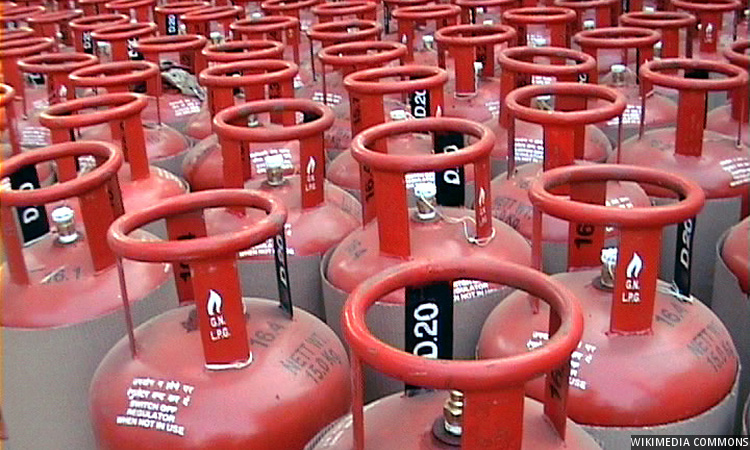Govt’s LPG Savings Not Rs 14,672 Crore But Rs 97-Crore Loss: Study

The government has said that direct transfers of subsidies to cooking-gas consumers have saved Rs 14,672 crore ($2.2 billion) but it actually led to a loss of Rs 97 crore ($14 million), according to an analysis by the Global Subsidies Initiative, a part of Canada-based International Institute For Sustainable Development (IISD).
The reduction in cooking-gas subsidies in 2014-15 was no more than Rs 143 crore ($21 million), the study said.
The government set aside Rs 200 crore ($30 million) to implement the direct benefit transfers for liquefied petroleum gas (DBTL), or Pratyaksh Hanstantrit Labh (PAHAL), of which Rs 40 crore ($6 million) were commissions paid in 2014-15, the study said, quoting the government’s own figures.
“Therefore, the maximum net saving, according to the government’s own figures—without accurately accounting for the costs of implementation and entirely discounting Rs 5,234 crore ($781 million) provided in permanent advances (and associated interest costs)—was approximately (-) Rs. 97 crore ($14 million),” the IISD report said.
On October 12, 2015, the government said 33.4 million consumers were blocked under PAHAL and related activities. “If we take into account the quota of 12 cylinders per consumer and the average LPG subsidy of Rs 336 [sic] per cylinder for the year 2014–15, estimated savings in LPG subsidy due to the blocking of 33.4 million accounts work out to Rs 14,672 crore ($2.2 billion), during that year,” the government's release said.
Subsidies have grown four-fold over the last 10 years, IndiaSpend reported earlier.
Petroleum subsidies increased from Rs 2,820 crore in 2007-08 to an estimated Rs 26,947 crore in the budget estimates for 2016-17, a nine-fold growth.
The petroleum subsidy peaked at Rs 96,880 crore ($17.9 billion at an exchange rate of Rs 54/$) in 2012-13 and declined to about Rs 30,000 crore ($4.4 billion) in the revised budget estimates for 2015-16.
Public data “clearly demonstrate” that DBTL was not responsible for identifying and blocking 33.4 million connections or even a significant fraction of this number, the IISD study said.
“… the large majority of the connections formally identified and blocked as of March 31, 2015 (and presented as blocked by DBTL) were done prior to the nationwide introduction of DBTL, and through methods entirely unrelated to DBTL or Aadhaar,” the report said.
Fake and duplicate connections unearthed—but not as the government claims
A large majority of potentially irregular connections were identified through a process unrelated to DBTL. “The only mechanism for identifying and blocking potentially irregular connections that was specific to the DBTL programme (as implemented) was Aadhaar-based de-duplication,” the IISD report said.
The government’s own figures have demonstrated that the maximum number of potential duplicates identified in LPG databases through Aadhaar-based de-duplication is approximately 1% (or less) of connections assessed—a figure that may relate to an even smaller percentage of consumption, the IISD study reported.
The list-based de-duplication was between 15 to 20 times more effective in identifying irregular connections than the Aadhaar-based method, while imposing less than 1% of the equivalent cost of implementation to both government and beneficiaries.
“In the case of LPG, the path to substantive subsidy reform is clear—reinstatement of a realistic per-household cylinder cap, adjustment of the per-cylinder price-to-subsidy ratio, a crash programme of access extension to all non-connected households, and rapid expansion and formalisation of access to smaller cylinders (both subsidised and unsubsidised),” the IISD study said.
The Finance Minister’s LPG expansion programme
During his budget speech, the Finance Minister announced plans to give cooking gas to 50 million households that live below the poverty line.
“We have decided to embark upon on a massive mission to provide LPG connection in the name of women members of poor households,” said Jaitley. “I have set aside a sum of Rs 2,000 crore ($290 million) in this year’s Budget to meet the initial cost of providing these LPG connections. This will benefit about 15 million households below the poverty line (BPL) in 2016-17. The scheme will be continued for at least two more years to cover a total of 50 million BPL households.”
The proposal has also been welcomed by experts. As columnist Swaminathan Anklesaria Aiyar wrote: “The analysis of Arun Jaitley’s Budget has focused on issues like the fiscal deficit, boost to infrastructure, and sundry tax measures. Yet in terms of life and death, by far his most important proposal is the scheme to provide LPG (cooking gas) to the poorest 50 million households over the next few years. This finally shows sensitivity to one of India’s greatest health hazards that has long been ignored…indoor pollution has always been a far greater health hazard, killing and maiming million… at last we have recognised a huge problem terribly neglected for decades.”


